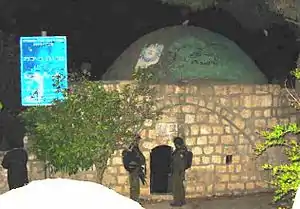Timnath-heres
Timnath-heres or Timnath-serah (Hebrew: תמנת חרס), later Thamna, was the town given by the Israelites to Joshua according to the Hebrew Bible. He requested it and the people gave it to him "at the order of the Lord". He built up the town and lived in it (Joshua 19:49–50).
 Shown within State of Palestine | |
| Location | Kifl Haris, West Bank |
|---|---|
| Region | Salfit Governorate |
| Coordinates | 32.119519°N 35.157183°E |
According to the Septuagint version of the Book of Joshua, Joshua placed there "the stone knives, with which he had circumcised the children of Israel".[1]
On his death, he was buried there (Joshua 24:30). Jewish tradition also places the tomb of Caleb there.
Etymology

In Joshua 19:49–50 and Joshua 24:30, the town is called Timnath-serah, whereas in Judges 2:9 it is named as Timnath-heres.
The name "Timnath-serah" signifies in Hebrew an "extra portion" or "portion of abundance". Similarly, the name "Timnath-heres" means "portion of the sun".[2] In the book of Joshua Chapter 24, verse 30; it is written in thirteen different published editions of the Old Testament as Timnath-Heres or some variation of it where the second word begins with an 'h', or 'H' and ends in 's', either with or without the intermediate dash. The inversion of "serah" to make "heres" has the connotation of sun, as in Job 9:7. Some allege that the figure of the sun was put on Joshua's monument, in commemoration of the miracle of the sun standing still for him.
In the Talmud the town is mentioned in Bava Batra 122b, where "heres" is translated as "earthenware," in reference to fruits in the area being as dry as earthenware prior to the arrival of Joshua.[3] The word's inversion, "serah" is defined as "rotting," that after Joshua's arrival, the fruits became so juicy that they could quickly rot.
Location
The town was located in the mountainous region of Ephraim, north of Mount Gaash.
It has variously been identified with the Palestinian village of Kifl Hares, located 6 kilometres west of Salfit in the West Bank;[4] or Khirbet Tibnah, located between Deir Nidham and Nabi Salih.[5][6]
Both E. Schürer and archaeologist W. F. Albright have identified the town with Thamna mentioned in Greco-Roman sources and in the writings of Josephus.[6][7] Eusebius, in his Onomasticon, mentions the site under the entry of Gaas (Mount Gaash), a mountain in Ephraim (Josh. 24:33), "near the village of Thamna."[8]
Conder & Kitchener of the Palestine Exploration Fund, steering clear of committing themselves to pinpointing the position of the biblical Timnath-heres in either Kifl Haris or Khirbet Tibnah, mention only the classical references to the place Thamnatha / Thamna (as in Pliny, Hist. Nat. v. 14 and in The Jewish War 3.3.5), saying that this place is to be identified with the present ruin Tibneh (marked on sheet xiv), and that "some have identified it with Timnath-heres."[9]
During the first-century CE until its destruction, Thamna served as an administrative district (toparchy).[10]
References
- Septuagint, after Joshua 21:42, quoted in Pulpit Commentary on Joshua 21, accessed 23 August 2016
- Dictionary.com, "Timnath-heres", accessed 21 August 2016
- The Schottenstein Daf Yomi Edition: Talmud Bavli. Tractate Bava Basra Mesorah Publications 2012. Page 112b1.
- Finkelstein et al, 1997, p. 460
- Finkelstein et al., 1997, p. 367
- Schürer, E. (1891), p. 158, note 438.
- Albright, W.F. (1923), p. 4
- Chapmann III, et al. (2003), p. 43 (s.v. Gaas)
- Conder & Kitchener (1882), pp. 299–300; ibid., p. 347; ibid., p. 377.
- Josephus, The Jewish War 3.3.5
Bibliography
- Albright, W.F. (1923). "Some Archaeological and Topographical Results of a Trip through Palestine". Bulletin of the American Schools of Oriental Research. The University of Chicago Press on behalf of The American Schools of Oriental Research. 11: 3–14. JSTOR 1354763.
- Chapmann III, R.L.; Taylor, J.E., eds. (2003). Palestine in the Fourth Century A.D.: The Onomasticon by Eusebius of Caesarea. Translated by G.S.P. Freeman-Grenville. Jerusalem: Carta. ISBN 965-220-500-1. OCLC 937002750.
- Conder, C.R.; Kitchener, H. H. (1882). The Survey of Western Palestine: Memoirs of the Topography, Orography, Hydrography, and Archaeology (Samaria). 2. London: Committee of the Palestine Exploration Fund.
- Finkelstein, I.; Lederman, Zvi, eds. (1997). Highlands of many cultures. Tel Aviv: Institute of Archaeology of Tel Aviv University Publications Section. ISBN 965-440-007-3.
- Schürer, E. (1891). Geschichte des jüdischen Volkes im Zeitalter Jesu Christi [A History of the Jewish People in the Time of Jesus Christ]. 1. Translated by Miss Taylor. New York: Charles Scribner's Sons.
External links
- Survey of Western Palestine, 1880 Map, Map 14: IAA, Wikimedia commons (Tibneh, shown to the left of Neby Saleh and Deir en Nidham)